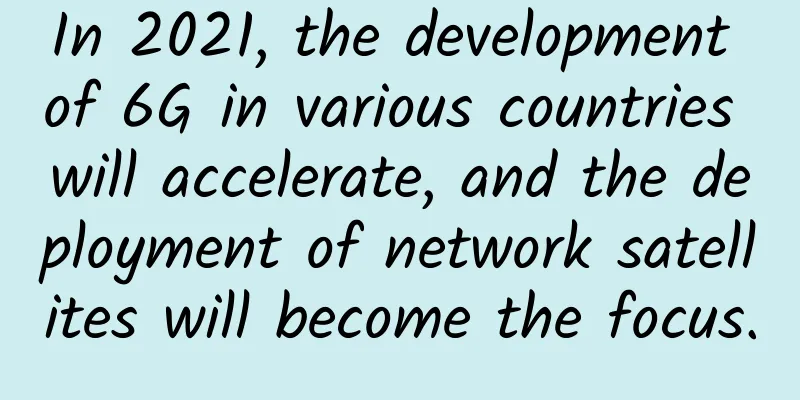In 2021, the development of 6G in various countries will accelerate, and the deployment of network satellites will become the focus.

|
Although 5G has only just become a reality, technologists are already working on the next important mobile network: 6G. Wireless communications are becoming increasingly important to people’s daily lives and corporate competitiveness. From driverless cars to coffee machines connected to the Internet, from smart sensors monitoring medical conditions to factories full of robots, the power of wireless technology is driving people’s lives and work forward.
With the rapid development of automation technology and the continuous expansion of virtual reality technology applications in the future, the demand for faster and safer communications is growing. If 6G can achieve the high transmission speed and ultra-low latency it pursues, it is expected to open up gigabit throughput, microsecond latency, and solve the problem of wireless transmission of holographic images. According to the Counterpoint report, 6G will be the first super-speed train to increase the wireless spectrum from a throughput of one gigabit per second to a transmission speed of one gigabit per second. Currently, many companies around the world suggest that the 6G spectrum range is from 300GHz to 3THz (TeraHertz). Although Samsung predicts that 6G will not be commercialized before 2028, given the experience of lagging behind China in 5G, countries are conducting research on 6G in full swing. In fact, giants like Huawei and Nokia are already moving forward in their own way. If we look at the spectrum, 4G was in MHz, 5G is in GHz, and 6G is in terahertz (THz). This leap in migration is indeed exponential. For 6G installations, many analysts report that it will require higher power efficiency, Line of Sight (LoS) channels, metamaterials for THz antenna arrays, improved AI and QoS for power optimization. In addition, THz spectrum will pave the way for holographic radio and ultra-massive MIMO technologies. As the speed increases to Terabits, the range of applications is also getting wider. Here are some key applications that will benefit from 6G (> 1Tbps):
Basically, with the booming development of low-orbit satellites, satellites have played an important role in the development of 5G, and it can be expected that satellites will also be important for 6G. In addition, in order to strengthen the layout of 6G, China has also launched the world's first 6G satellite for terahertz communication. Since terahertz communication technology is expected to become one of the basic technologies of 6G networks in the future, it seems that China is stepping up its pace in 6G research and development, hoping to break through 6G technology more than the United States and Europe and establish many patent barriers. |
>>: Transforming the network to support remote work as a norm
Recommend
A practical guide to running databases across regions and Kubernetes clusters
Translator | Kang Shaojing Planning | Yun Zhao Am...
80VPS: Korean CN2 server starting from 350 yuan/month, 2*E5-2450L/8GB/1TB/10M bandwidth/quick launch
80VPS is a Chinese hosting company that was estab...
GreenCloudVPS Kansas node is online, 2G memory package starts at $15 per year
GreenCloudVPS has launched its 30th data center p...
Launchvps: $19.95/year KVM-768MB/20GB/768GB/Philadelphia Data Center
Launchvps recently launched two special annual pa...
HostDare: $10.4/year-1.5GB/10G NVMe/1000GB/Los Angeles data center
In addition to offering a 40% discount code for t...
Starting from a large amount of real data, we analyze the employee remuneration of China Unicom
China Unicom released its 2020 performance report...
ZJI: 580 yuan/month 2×E5-2630L, 32G memory, 480G SSD, 10M bandwidth, Hong Kong Confederation data center
ZJI is a well-known hosting company in the WordPr...
DediPath: 1Gbps unlimited traffic high-security server starting at $39/month, E3-1240v2/16GB/2TB/Los Angeles
It has been a few months since I shared informati...
5G may disappoint consumers because it has no other advantages except fast speed
Less than four years after the issuance of 4G lic...
[11.11] LOCVPS top up 100 yuan and get 10 yuan, all hosts are 60% off, Hong Kong VPS monthly payment starts from 22 yuan
LOCVPS officially announced the promotion during ...
Telling the story of HTTPS
Starring in the story: Xiaohua is a freshman this...
What is the transport layer protocol?
Transport layer protocols are an important part o...
Media Statement on the U.S. Department of Commerce’s Modification of the Direct Product Rule Regarding Huawei
Huawei strongly opposes the US Department of Comm...
A graphic guide to selecting network equipment
Hello everyone, I am Xiao Fu. Illustrated network...
From trials to use cases, the big 5G stories of 2017
In 2017, 5G gradually moved from the laboratory t...









